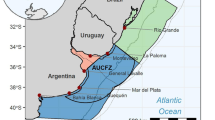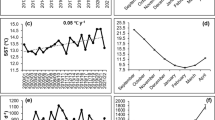Abstract
Using the Food and Agriculture Organization’s (FAO) Mediterranean capture fisheries production dataset in conjunction with global and Mediterranean sea surface temperatures, we investigated trends in fisheries landings and landings per unit of effort of commercially important marine organisms, in relation to temperature oscillations. In addition to the overall warming trend, a temperature shift was detected in the Mediterranean Sea in the late 1990s. Fisheries landings fluctuations were examined for the most abundant commercial species (59 species) and showed significant year-to-year correlations with temperature for nearly 60 % of the cases. From these, the majority (~70 %) were negatively related and showed a reduction of 44 % on average. Increasing trends were found, mainly in the landings of species with short life spans, which seem to have benefited from the increase in water temperature. Τhe effect of oceanic warming is apparent in most species or groups of species sharing ecological (e.g. small and medium pelagic, demersal fish) or taxonomic (e.g. cephalopods, crustaceans) traits. A landings-per-unit-of-effort (LPUE) proxy, using data from the seven Mediterranean European Union member states, also showed significant correlation with temperature fluctuations for six out of the eight species examined, indicating the persistence of temperature influence on landings when the fishing effect is accounted for. The speed of response of marine landings to the warming of the Mediterranean Sea possibly shows both the sensitivity and the vulnerable state of the fish stocks and indicates that climate should be examined together with fisheries as a factor shaping stock fluctuations.







Similar content being viewed by others
References
Barale V, Jaquet JM, Ndiaye M (2008) Algal blooming patterns and anomalies in the Mediterranean Sea as derived from the SeaWiFS dataset (1998–2003). Rem Sens Environ 112:3300–3313
Behrenfeld MJ, O'Malley RT, Siegel DA, McClain CR, Sarmiento JL, Feldman GC, Milligan AJ, Falkowski PG, Letelier RM, Boss ES (2006) Climate-driven trends in contemporary ocean productivity. Nature 444(7120):752–755
Bethoux JP, Gentili B (1999) Functioning of the Mediterranean Sea: past and present changes related to freshwater input and climate changes. J Mar Syst 20:33–47
Bethoux JP, Gentili B, Morin P, Nicolas E, Pierre C, Ruiz-Pino D (1999) The Mediterranean Sea: a miniature ocean for climatic and environmental studies and a key for the climatic functioning of the North Atlantic. Prog Oceanogr 44(1–3):131–146
Bianchi CN, Morri C (2000) Marine biodiversity of the Mediterranean Sea: situation, problems and prospects for future research. Mar Poll Bull 40:367–376
Blanchard JL, Jennings S, Holmes R, Harle J, Merino G, Allen JI, Holt J, Dulvy NK, Barange M (2012) Potential consequences of climate change for primary production and fish production in large marine ecosystems. Phil Trans R Soc B 367:2979–2989
Bopp L, Aumont O, Cadule P, Alvain S, Gehlen M (2005) Response of diatoms distribution to global warming and potential implications: a global model study. Geophys Res Lett 32, L19606. doi:10.1029/2005GL023653
Brander KM (2007) Global fish production and climate change. PNAS 104:19709–19714
Brander K (2010) Impacts of climate change on fisheries. J Mar Syst 79:389–402
Caddy JF, Rodhouse PG (1998) Cephalopod and groundfish landings: evidence for ecological change in global fisheries? Rev Fish Biol Fish 8:431–444
Caddy JF, Refk R, Do-Chi T (1995) Productivity estimates for the Mediterranean: evidence of accelerating ecological change. Ocean Coast Manage 26(1):1–18
Cheung WWL, Watson R, Pauly D (2013) Signature of ocean warming in global fisheries catch. Nature 497:365–368
Doney SC (2006) Oceanography: plankton in a warmer world. Nature 444:695–696
El Boukhary MS, Ruiz-Pino D, Béthoux JP (2002) Is the oxygen decreasing. In: The Mediterranean Sea? EGS General Assembly Conference Abstracts. EGS XXVII General Assembly, SAO/NASA Astrophysics Data System
European Union (2010) Fleet register on the net. Accessed at: http://ec.europa.eu/fisheries/fleet/index.cfm
Fréon P, Mullon C, Voisin B (2003) Investigating remote synchronous patterns in fisheries. Fish Oceanogr 12:443–457
Froese R, Kleiner K, Zeller D, Pauly D (2012) What catch data can tell us about the status of global fisheries. Mar Biol 159(6):1283–1292
Gregg WW, Conkright ME, Ginoux P, O’Reilly JE, Casey NW (2003) Ocean primary production and climate: global decadal changes. Geophys Res Lett 30:3–1
Hsieh CH et al (2006) Fishing elevates variability in the abundance of exploited species. Nature 443:859–862
IPCC (2007) Intergovernmental panel on climate change. Climate change 2007: impacts, adaptation and vulnerability. Cambridge Univ. Press
Jennings S, Brander K (2010) Predicting the effects of climate change on marine communities and the consequences for fisheries. J Mar Syst 79:418–426
Jennings S, Rice J (2011) Towards an ecosystem approach to fisheries in Europe: a perspective on existing progress and future directions. Fish Fish 12:125–137
Jones PD, Parker DE, Osborn TJ, Briffa KR (2008) Global and hemispheric temperature anomalies—land and marine instrumental records. In: Trends: a compendium of data on global change. Carbon Dioxide Information Analysis Center, Oak Ridge National Laboratory, U.S. Department of Energy
Large WG, Yeager SG (2012) On the observed trends and changes in global sea surface temperature and air–sea heat fluxes (1984–2006). J Climate 25:6123–6135
Lejeusne C, Chevaldonné P, Pergent-Martini C, Boudouresque CF, Pérez T (2010) Climate change effects on a miniature ocean: the highly diverse, highly impacted Mediterranean Sea. TREE 25:250–260
Lleonart J, Maynou F (2003) Fish stock assessment in the Mediterranean: state of the art. Scientia Marina 67:37–49
Ludwig W, Dumont E, Meybeck M, Heussner S (2009) River discharges of water and nutrients to the Mediterranean and Black Sea: major drivers for ecosystem changes during past and future decades? Prog Oceanogr 80:199–217
Manca B, Burca M, Giorgetti A, Coatanoan C, Garcia M-J, Iona A (2004) Physical and biochemical averaged vertical profiles in the Mediterranean regions: an important tool to trace the climatology of water masses and to validate incoming data from operational oceanography. J Mar Syst 48:83–116
Martín P, Sabatés A, Lloret J, Martin-Vide J (2012) Climate modulation of fish populations: the role of the Western Mediterranean Oscillation (WeMO) in sardine (Sardina pilchardus) and anchovy (Engraulis encrasicolus) production in the north-western Mediterranean. Clim Change 110(3–4):925–939
Myers N, Mittermeier RA, Mittermeier CG, da Fonseca GAB, Kent J (2000) Biodiversity hotspots for conservation priorities. Nature 403:853–858
Nykjaer L (2009) Mediterranean Sea surface warming 1985–2006. Clim Res 39:11–17
Ottersen G, Hjermann DO, Stenseth NC (2006) Changes in spawning stock structure strengthen the link between climate and recruitment in a heavily fished cod (Gadus morhua) stock. Fish Oceanogr 15:230–243
Pauly D, Watson R, Alder J (2005) Global trends in world fisheries: impacts on marine ecosystems and food security. Phil Trans R Soc B Biol Sci 360(1453):5–12
Pyper BJ, Peterman RM (1998) Comparison of methods to account for autocorrelation in correlation analyses of fish data. Can J Fish Aquat Sci 55:2127–2140
Raitsos DE, Beaugrand G, Georgopoulos D, Zenetos A, Pancucci-Papadopoulou MA et al (2010) Global climate change amplifies the entry of tropical species into the eastern Mediterranean Sea. Limnol Oceanogr 55:1478–1484
Raitsos DE, Lavender SJ, Pradhan Y, Tyrrell T, Reid PC, Edwards M (2006) Coccolithophore Bloom Size Variation in Response to the Regional Environment of the Subarctic North Atlantic. Limnol Oceanogr 51:2122–2130
Reid PC, Beaugrand G (2012) Global synchrony of an accelerating rise in sea surface temperature. J Mar Biol Assoc UK 92:1435–1450
Rixen M, Beckers J-M, Levitus S, Antonov J, Boyer T, Maillard C, Fichaut M, Balopoulos E, Iona S, Dooley H, Garcia M-J, Manca B, Giorgetti A, Manzella G, Mikhailov N, Pinardi N, Zavatarelli M (2005) The Western Mediterranean deep water: a proxy for climate change. Geophys Res Lett 32:1–4
Rodionov SN (2004) A sequential algorithm for testing climate regime shifts. Geophys Res Lett 31. doi:10.1029/2004GL019448
Sara G, Lo Martire M, Sanfilippo M, Pulicano G, Cortese G, Mazzola A, Manganaro A, Pusceddu A (2011) Impacts of marine aquaculture at large spatial scales: evidences from N and P catchment loading and phytoplankton biomass. Mar Environ Res 71:317–324
SeaWiFS (2013) SeaWiFS project. Accessed at: http://oceancolor.gsfc.nasa.gov/SeaWiFS/
Swanson KL, Tsonis AA (2009) Has climate recently shifted? Geophys Res Lett 36:L06711. doi:10.1029/2008GL037022
Takasuka A, Oozeki Y, Kubota H, Lluch-Cota SE (2008) Contrasting spawning temperature optima: why are anchovy and sardine regime shifts synchronous across the North Pacific? Prog Oceanogr 77:225–232
Ting M, Kushnir Y, Seager R, Li C (2009) Forced and internal twentieth-century SST trends in the North Atlantic. J Climate 22:1469–1481
Tsiaras KP, Kourafalou VH, Raitsos DE, Triantafyllou G, Petihakis G, Korres G (2012) Inter-annual productivity variability in the North Aegean Sea: influence of thermohaline circulation during the Eastern Mediterranean Transient. J Mar Syst 96–97:72–81
Tsikliras AC (2008) Climate-related geographic shift and sudden population increase of a small pelagic fish (Sardinella aurita) in the eastern Mediterranean Sea. Mar Biol Res 4:477–481
Tzanatos E, Castro J, Forcada A, Matić-Skoko S, Gaspar M, Koutsikopoulos C (2013) A Métier-Sustainability-Index (MSI25) to evaluate fisheries components: assessment of cases from data-poor fisheries from southern Europe. ICES J Mar Sci 70(1):78–98
Vargas-Yáñez M et al (2008) Warming trends and decadal variability in the Western Mediterranean shelf. Glob Planet Chang 63:177–184
Verity PG, Smetacek V (1996) Organism life cycles, predation, and the structure of marine pelagic systems. Mar Ecol Prog Ser 130:277–293
Volpe G, Nardelli BB, Cipollini P, Santoleri R, Robinson IS (2012) Seasonal to interannual phytoplankton response to physical processes in the Mediterranean Sea from satellite observations. Rem Sens Environ 117:223–235
Watson R, Pauly D (2001) Systematic distortions in world fisheries catch trends. Nature 414:534
Woodworth-Jefcoats PA, Polovina JJ, Dunne JP, Blanchard JL (2013) Ecosystem size structure response to 21st century climate projection: large fish abundance decreases in the central North Pacific and increases in the California Current. Glob Chang Biol 19(3):724–733
Worm B, Myers RA (2004) Managing fisheries in a changing climate—no need to wait for more information: industrialized fishing is already wiping out stocks. Nature 429:15
Acknowledgments
We would like to thank Tassos Eleftheriou, Margaret Eleftheriou, Daniel Pauly, George Sugihara, John Steele, Themis Chronis and especially Anthony J. Richardson for their comments on early drafts of this manuscript. We would also like to thank the Associate Deputy Editor and two anonymous referees for their comments on the manuscript. This research was supported by: a) OPEC European Project (283291) supported within DG SPACE for the FP7 for Cooperation, b) MEECE European Project (212085) supported within Theme 6 Environment of the Seventh Framework Programme for Research and Technological Development, and c) the Southern European Seas Assessing and Modeling (SESAME) project, European Commission Contract GOCE-036949, funded by the European Commission’s Sixth Framework Programme under the priority “Sustainable Development, Global Change and Ecosystems.”
Author information
Authors and Affiliations
Corresponding author
Additional information
Evangelos Tzanatos and Dionysios E. Raitsos equally contributed to this work.
Rights and permissions
About this article
Cite this article
Tzanatos, E., Raitsos, D.E., Triantafyllou, G. et al. Indications of a climate effect on Mediterranean fisheries. Climatic Change 122, 41–54 (2014). https://doi.org/10.1007/s10584-013-0972-4
Received:
Accepted:
Published:
Issue Date:
DOI: https://doi.org/10.1007/s10584-013-0972-4




